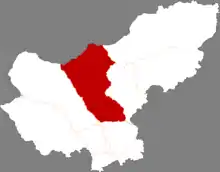Abaga horse
The Abaga (simplified Chinese: 阿巴加马; traditional Chinese: 阿巴加馬; pinyin: Abaga) is a type of Chinese Mongolian horse. Characterized by its generally black coat, it is also larger and faster than the latter, due to its selection for racing.
| Country of origin | China |
|---|---|
| Use | Saddle horse, and mare milk |
| Traits | |
| Height |
|
| Color | Generally black |
With fewer than 4,000 members at the end of 2008, the Abaga is a rare breed.
History
Little is known about these horses. The Abaga does not feature in the study of equine populations conducted by Rupak Khadka at Uppsala University, published in August 2010 for the FAO.[1] Nor is it mentioned in the DAD-IS database.[2]
However, the 2016 edition of the CAB International book refers to the breed as Black Abaga,[3] while scientific publications refer to it as Abaga.[4][5] According to the Delachaux guide (2014), it is also referred to as the "Sengseng black horse".[6] However, the same publication also refers to the breed under the erroneous name of "Black Agaba".[6]

Although ancient and the result of long selection,[7] the Abaga was only officially characterized in 2009.[6] Little is known about the different types of Mongolian horse, with research efforts focusing more on Thoroughbreds and Quarter Horses.[8] Genetic research on this breed is motivated (2018) in particular by research into racing performance during the Naadam,[5] in order to improve the speed of the different strains of Mongolian horses.[9]
Description
The Abaga is a typical steppe horse.[10] According to the Delachaux guide, its average height is 1.36 m to 1.40 m.[6]
The head is straight or slightly convex, with a broad forehead, large eyes and small ears.[6] The neck is fairly long.[6] The withers are rather flat.[6] The chest is broad and the shoulders muscular.[6] The back is fairly long, and the rump short, with a slight slope.[6] Hooves are small and hard.[6]
The coat is predominantly black, more rarely dark bay.[6]
These horses are renowned for their stamina and good temperament.[6] They are extremely hardy, enabling them to live outdoors, on high plateaus, all year round, at low temperatures, with little rainfall, and in a hypoxic environment.[7]
Usage
The Abaga is primarily a racehorse, whose speed was measured over 1,600 meters by the Chinese Animal Genetic Resources Commission in 2011.[10] It is notably faster than the Wushen, another type of Mongolian horse.[11] It seems that this speed is the result of selective breeding, which favors certain characteristics such as heart and muscle development.[12]
It could be used for pleasure riding, and is also bred for meat and mare milk.[6]
Spread of breeding

As its name suggests, the Abaga originates from the northern Abag Banner in the Xilingol League, Inner Mongolia.[6][13][14] It is a rare breed overall, with 3,758 individuals recorded at the end of 2008.[6]
References
- Khadka, Rupak (2010). "Global Horse Population with respect to Breeds and Risk Status" (PDF). Faculty of Veterinary Medicine and Animal Science - Department of Animal Breeding and Genetics.
- "Browse by species and country". DAD-IS.
- Porter et al. (2016, p. 432)
- Wang, Wei; Wang, Shenyuan; Hou, Chenglin; Xing, Yanping (2014). "Genome-Wide Detection of Copy Number Variations among Diverse Horse Breeds by Array CGH". PLOS ONE. 9 (1). doi:10.1371/journal.pone.0086860. ISSN 1932-6203. Retrieved 14 May 2018.
- Pan et al. (2018, p. 3)
- Rousseau (2014, p. 359)
- Wang, Wei; Wang, Shenyuan; Hou, Chenglin; Xing, Yanping (2014). "Genome-Wide Detection of Copy Number Variations among Diverse Horse Breeds by Array CGH". PLoS ONE. 9 (1). Retrieved 9 November 2018.
- Pan et al. (2018, p. 3-4)
- Pan et al. (2018, p. 5)
- Pan et al. (2018, p. 4)
- Pan et al. (2018, p. 11)
- Pan et al. (2018, p. 12)
- Porter et al. (2016, p. 453)
- "China-Mongolia international horse racing kicks off - Xinhua | English.news.cn". www.xinhuanet.com. Retrieved 9 November 2018.
Bibliography
- Porter, Valerie; Alderson, Lawrence; Hall, Stephen; Sponenberg, Dan (2016). Mason's World Encyclopedia of Livestock Breeds and Breeding (6th ed.). CAB International. ISBN 1-84593-466-0.
- Rousseau, Élise (2014). "Agaba noir". Tous les chevaux du monde (in French). Delachaux et Niestlé. ISBN 2-603-01865-5.
- Pan, Jing; Purev, Chimge; Zhao, Hongwei; Zhang, Zhipeng; Wang, Feng; Wendoule, Nashun; Qi, Guichun; Zhou, Huanmin (21 May 2018). "Exercise-related genes analysis of Mongolian Horse". bioRxiv 10.1101/327536.